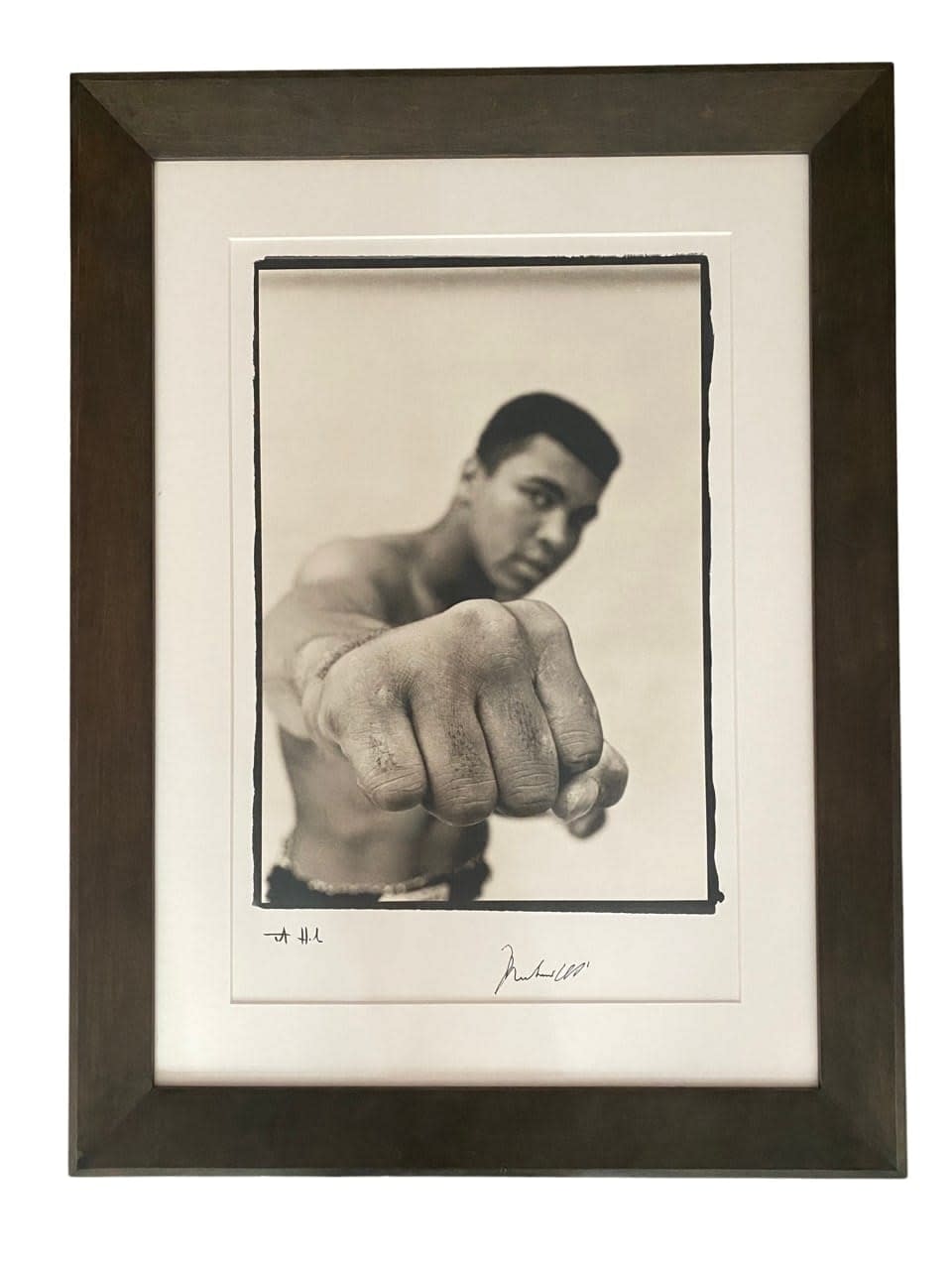Photography
Thomas Hoepker
22 x 30 in
Ali was and is the greatest. A great sportsman, he was a controversial thinker that enthralled people but also offended many in and outside of the ring.
Thomas Hoepker had the opportunity to spend time with Cassius Clay aka Muhammad Ali and take photographs in 1960 when he won a gold medal at the Rome Olympics. In 1966, when Ali was world heavyweight champion already; then again in 1970, when he, after several years of a forced absence from the ring, restarted his career and prepared himself for the ‘Fight of the Century’ against Joe Frazier; and years later, already weakened by Parkinson’s disease.
August of 1966. Twenty years before entering Magnum Agency, the German photographer Thomas Hoepker is in Chicago (United States) to photograph Muhammad Ali, boxing world heavy weight champion, in an assignment for Stern magazine.
Hoepker had got his first pictures of him six years before during the 1960 Olympic Games, when his name was Cassius Clay and being only eighteen years old took his starting steps on the international stage, becoming an instant sensation in the light heavyweight category after defeating much more experienced boxers than him like the Russian Gennady Shatkov, the Canadian Tony Madigan and the Polish Zbigniew Pietrzykowski, winning the Olympic title.
Muhammad Ali has been the undisputed boxing heavyweight champion of the world for two years, after beating Sony Liston on February 26, 1964 at the Miami Beach Convention Hall.
Following it, Cassius Clay has changed his name to Muhammad Ali and has successfully defended his title against Floyd Patterson (Las Vegas Convention Center on November 22, 1965), George Chuvalo (Maple Leaf Gardens in Toronto on March 29, 1966), Henry Cooper (Arsenal Football Stadium London on May 21, 1966) and Brian London one week before also in the British capital.
Thomas Hoepker doesn´t know anything about boxing but right off the bat he does realize that this is a once in a lifetime chance, since Muhammad Ali arrival at the boxing scope has meant to all intents and purposes a revolution in this sport, because of a number of reasons:
a) Ali´s boxing style and attitude on the ring is utterly different to everything known hitherto, with incredible speed of movements and blows, and he has got a remarkable insight to use its fists with devastating effect during the key instants of every bout.
As a matter of fact, though he is the heavyweight champion of the world, he is faster than the best Superwelter world champion boxers of the time.
In addition, his defense is amazing, and most times he avoids being hit by his opponents through swift movements of his body, to such an extent that it´s exceedingly difficult to knock him out.
b) His physical condition is superb. He works out to exhaustion every day inside gym, running many kilometers and doing a wide range of physical activities. This way, he preserves virtually the same stamina on the ring from beginning to end of every contest.
c) Unlike what´s usual in such a tough sport like this in which vast majority of boxers show signs of impacts in fights on their countenances, Muhammad Ali´s face appears immaculate, without any trace of blows, because his outstanding technique enables him to remain almost untouched once and again.
d) Unlike most heavy weight champions featuring a hard man profile, Muhammad Ali could pass as a cinema actor. He´s handsome, very athletic, charming, flamboyant, wearing elegant attire, boasting a unique personality, steadily proclaiming that he is the best boxer ever seen and his famous statement " I float like a butterfly and sting like a bee ", in the midst of a maelstrom of changing moods.
From a photographic viewpoint this is a very interesting person and a great chance to strive upon unfolding his most significant traits through images.
This way, Thomas Hoepker begins following Muhammad Ali all over Chicago while he walks across the streets, trains inside the gym, runs long distances to be as fit as feasible, poses both with friends and performing boxing movements and blows, etc.
The German photographer makes him very good pictures, some of them standing and jumping on a bridge overlooking the Chicago river and the city´s skyline, shooting at f/11 with his Leica MP-88 rangefinder camera coupled to a 35 mm wideangle lens and getting extensive depth of field, rendering the main skyscrapers and factory chimneys visible in the background with outstanding sharpness.
But the magical moment arrives a few days later, during the evening, when Muhammad Ali is inside a gym training hard.
Thomas Hoepker is near him, but light conditions are rather subdued and he thinks he won´t be able to get any good photograph.
Suddenly, Muhammad Ali spontaneously approaches him looking at the camera and begins to deliver blows in the air as if fighting against a rival boxer.
Very quickly, Hoepker, who has got his 24 x 36 mm format the Leicavit rapid advance lever, managing to create three images, one of the right fist (number 9A of the 35 mm contact sheet) and two of the left one (numbers 8A and the underexposed 10A).
Everything happens in a very fast way, and suddenly, Muhammad Ali comes back to keep on exercising on the punching bag.
Thomas Hoepker managed to get an exceedingly representative picture, highlighting Muhammad Ali´s right fist as main tool of his trade, using the f/2 aperture of the Summilux-M 35 mm f/1.4 wideangle lens coupled to his Leica MP camera.
Obviously, the most important ingredients for the creation of this image were by far the previous toil of the German photographer following the famous boxer everywhere (establishing a not easy to attain rapport with him, sometimes extremely friendly and funny and other times as days went by, and subsequently photographing the boxing heavyweight champion of the world in a number of different locations and hours of the days, both alone and with his entourage of relatives and acquaintances), the choice of a vertical framing and Hoepker´s quickness of movements and remarkable speed shooting to get the picture.
But it isn´t less true that this photograph is hugely interesting from the vewpoint of its fabulous overall vintage image aesthetics, its stunning level of detail on the focused right fist area yielded at f/2 and the very beautiful bokeh in Muhammad Ali´s out of focused face, right shoulder and arm, right side, abdominal areas and upper trunks.
Join our mailing list
* denotes required fields
We will process the personal data you have supplied to communicate with you in accordance with our Privacy Policy. You can unsubscribe or change your preferences at any time by clicking the link in our emails.

